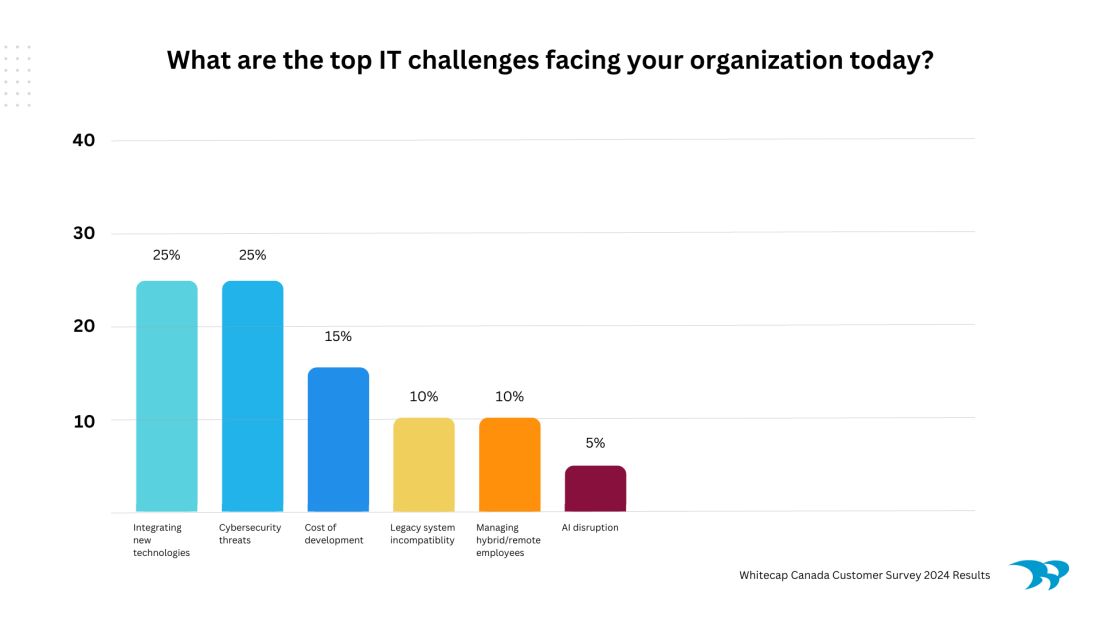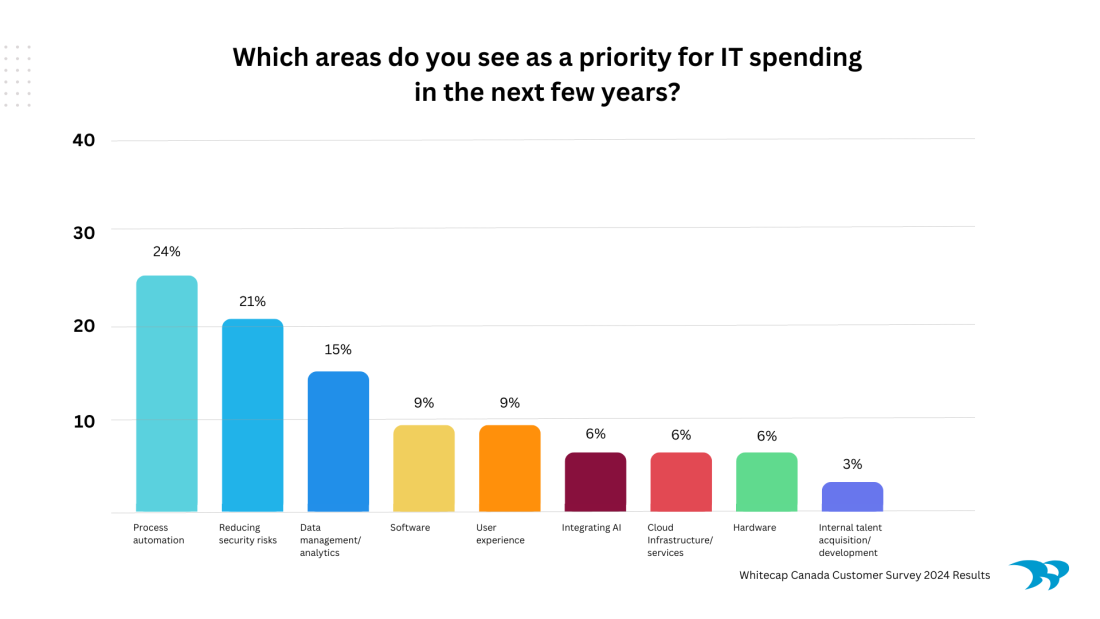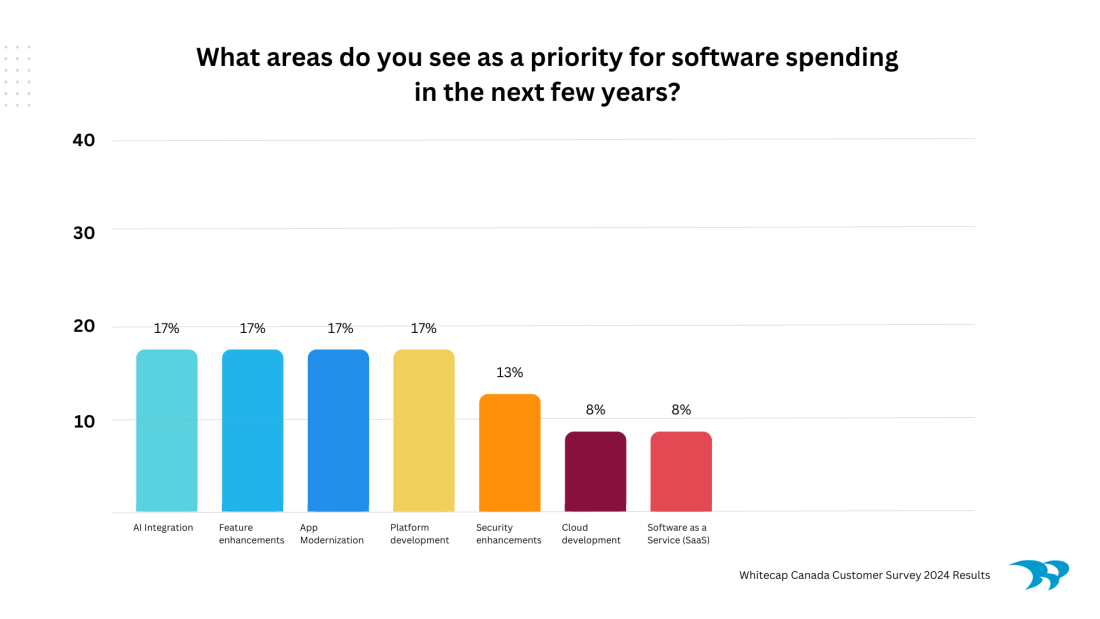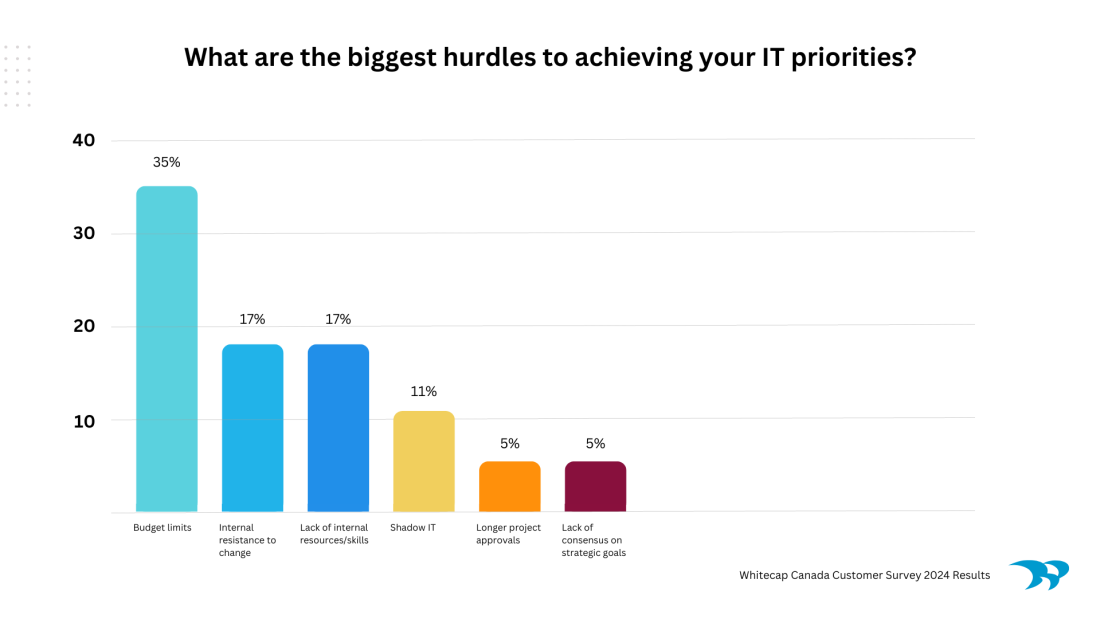|
Getting your Trinity Audio player ready...
|
Every year, we survey our clients across Canada and the US to understand their top priorities and challenges in the coming year. For this year’s industry snapshot, we reached out to CIOs and other C-suite roles as well as professionals in IT and various verticals who are involved in planning for and/or implementing technology and software. The cohort comprises companies of varying sizes from across multiple industries.
This look at 2025 tech and software development trends, reveals a subtly shifting landscape, and how things ¾opportunities and challenges¾ will play out in the year ahead.
Executive Summary: Top 3 Takeaways
As in previous years, AI and automation top the list of priorities, but this year, we’re seeing a growing maturity around how to ensure that any newly adopted technology has a tangible, positive impact. But despite the agreement that digital transformation is non-negotiable, concern around integration and security remains high.
Our survey, in tandem with several emerging industry developments, reveals a few significant trends that are making their way to the forefront for 2025.
1. More Strategy Required
In 2024, many companies were focused on understanding how to integrate AI into their existing structures. However, as we move into 2025, organizations are adopting a more strategic approach. This involves not only selecting the most effective AI tools but also developing comprehensive strategies that align AI initiatives with overall business goals, ensuring they deliver tangible value.
By integrating AI solutions tailored to your operations and priorities, organizations can drive efficiency and unlock new opportunities for growth. For example, a manufacturing company might leverage AI-driven predictive analytics to optimize inventory management and reduce downtime, while a retailer could use AI recommendation engines to forecast demand or personalize product suggestions, boosting conversion rates.
Embedding AI into your core business process can transform challenges into opportunities that deliver measurable results…but only if you plan. Without a clear strategy, proper integration, and alignment with business goals, AI projects may fail to deliver the expected results.
Earlier this year we published an 8-step guide on how to build a business case for custom software. From identifying the business need, engaging stakeholders and establishing requirements, to defining success metrics, budgeting and mitigating risks, this is a great roadmap to follow for any technology project, including AI.
2. Security Concerns Continue
With the rise in cyber threats, IT departments are more vigilant than ever in addressing vulnerabilities, particularly at the software level. They are implementing robust measures to secure websites, applications, and email systems. IT leaders are also exploring AI-driven security solutions that can proactively identify and mitigate risks, ensuring a safer digital environment for their organizations. For example, securing API endpoints, validating input and output data, and monitoring for suspicious activity. By adopting a proactive approach to API security, organizations can significantly reduce their risk of data breaches, service disruptions, and reputational damage.
3. Hope is on the Horizon
Many leaders are grappling with stagnant budgets and personnel shortages, making it difficult to implement new initiatives or enhance existing systems. At Whitecap, we often see this manifesting as longer and more complex project approval cycles, tighter budgets and increased scrutiny from decision-makers. These challenges can sometimes lead to delays or projects being cancelled.
However, there’s a growing sense of optimism that budgets will begin to increase in 2025, driven by a renewed focus on digital transformation and the necessity for enhanced technological capabilities.
At Whitecap, we’ve been working hard to understand the obstacles you face and are committed to helping you make the most of your technology investments. From legacy application modernization to AI integration and workflow optimization, we’ll work closely with you to develop tailored strategies that maximize ROI, even in resource-constrained environments.
Top 2025 Priorities & Challenges for Tech & Software Development
Let’s dig into the nitty-gritty of the survey, which comprised four key areas:
- Top IT challenges today,
- Top priorities for IT spending,
- Top priorities for software spending, and
- Biggest hurdles facing IT leaders in 2025.
1. Top IT Challenges Today
IT leaders are tasked with helping organizations achieve their strategic priorities. Serving as “change makers” they act as a bridge between a business road map and any technological and software investments. However, despite this critical role, they remain tethered to the daily challenges that arise from the effort to optimize and modernize their technology infrastructure.
Not surprisingly, when polled, integrating new technologies (like AI) tops the list at 25% as one of the biggest challenges today. It’s little wonder, as these professionals sit at the crossroads of advancing business objectives and ensuring operational efficiencies.
Data breaches from malware attacks and phishing attempts continue to threaten organizations around the world. According to IBM, US4.88M is the “global average cost of a data breach in 2024—a 10% increase over last year and the highest total ever.” In our survey, cybersecurity threats were keeping our IT leaders awake at night, checking in with 25% of the survey results.
By integrating new technologies, CIOs and IT leaders hope to unlock hidden organizational potential and become more agile (and secure!) in the process. However, the cost of development (15%) in the face of tight budgets has made it difficult to address these two challenges.
The Whitecap POV: While organizations have been dabbling in AI and other new technologies, making sure they are fully realized in terms of potential is another matter. Success is hinged on alignment between all stakeholders to ensure that new applications are strategically integrated and readily adopted by employees. To start your project off on the right foot, be sure to check out our modernization guide.
 2. Top Priorities for IT Spending in 2025
2. Top Priorities for IT Spending in 2025
When polled, IT leaders noted that process automation tops the list as a major area of investment (24%) followed closely by reducing security risks (21%) and data management and analytics rounding out the top three with 15%.
This jibes with Gartner’s recent poll that shows more than 80% of surveyed CIOs plan to increase investments in generative AI, data analytics, integration technologies/APIs and cybersecurity.
No-to-low code tools, like Power Automate, empower employees to play a role in organizational digital transformation, without straining IT resources. (As we reported earlier this year, 93% of all Fortune 500 companies at turning to Power Automate.) Users can harness this AI-driven solution to accelerate automation, generate content, create models, analyze data and get actionable recommendations.
Businesses want the ability to mine their rising amounts of structured and unstructured data to spot market trends, support business decisions and stay ahead of the competition. Yet, the reality is that companies are truly struggling to extract actionable insights. (A recent report on the health sector noted that 97% off all data collected by hospitals goes unused!) The year ahead will see a concerted effort to better harness data.
The Whitecap POV: Companies are increasingly recognizing AI’s potential to drive efficiency, enhance customer experiences, and unlock the value of their data, leading to more deliberate and impactful investments. In 2025, we will see AI-powered tools like Microsoft’s Power BI and the Microsoft Power Platform used to advance process automation and data management. Why? It’s user-friendly, highly scalable, offers rich feature sets and a range of licensing options – ideal for every budget.
 3. Top Priorities for Software Spending in 2025
3. Top Priorities for Software Spending in 2025
While there are clear-cut priorities for technology spending, when it comes to software, IT leaders are torn in different directions. The priorities of AI integration, feature enhancements, app modernization and platform development are all tied at 17% each.
There is no doubt a strong desire to take advantage of new technologies like AI, microservices and platform solutions in order to improve the functionality, management, and user experience of apps. (ZDnet recently reported that enterprise automation is set to get an AI-first upgrade). But the reality of mounting technical debt makes it a balancing act between integrating new technologies and modernizing legacy software to prevent the problems that can arise with outdated solutions.
Following closely at 13%, our surveyed tech leaders responded that security enhancements were next on the agenda. Due to its robust Microsoft security, we are seeing our clients really leaning into the benefits of Power Platform. And with custom software, more and more organizations may be stepping back from outsourcing abroad, where cheap prices often come at the cost of sloppy security practices or even maliciously inserted code. (At Whitecap, we always design and build apps with security top of mind making infiltration very difficult for bad actors.)
The Whitecap POV: In 2024, we saw companies dabbling in AI, with individual employees or teams testing out AI capabilities within the tools they use ¾ like Teams, Outlook, Power BI, SharePoint, Canva, MidJourney, ChatGPT ¾ to see where AI can have the most impact, before investing in broader, custom models. Before forging ahead, organizations should take a step back and evaluate their readiness for further investment. Check out our guide Artificial Intelligence is Here: Are you Ready?
 4. What are the Biggest Hurdles IT Leaders Face in Achieving their Priorities?
4. What are the Biggest Hurdles IT Leaders Face in Achieving their Priorities?
Out of the gate, 35% of Whitecap survey responders said budget limits were the biggest hurdle. Yet, there was a healthy dose of optimism. Nine in 10 tech leaders expect a bump in IT spending in 2025. And three-quarters of executives “anticipate larger budgets for software and technical personnel, driven by growing enterprise appetite for AI capabilities and broader modernization initiatives.”
Internal challenges like lack of resources/skills (17%) and resistance to change (17%) also stand in the way of achieving their goals. Retaining and upskilling talent in a highly competitive market will be something IT leaders will have to keep a sharp eye on in 2025. Equally important, engaging employees in the process of change and transformation will be critical to achieving business goals.
The Whitecap POV: This potential uplift in budgets offers hope for IT teams to expand their resources, invest in talent, and ultimately better support their organizations in an increasingly complex landscape. And don’t forget to research government funding opportunities. Here in Ontario, companies have until December 20th, 2024, to apply for funding to help bring new AI technologies to fruition through the Regional Artificial Intelligence Initiative (RAII). And not-for-profit and community development organizations should investigate this government funding opportunity for technology projects.
Earlier this year, Sharyn Leaver, chief research officer at Forrester, commented, “Optimistic budget expectations will serve leaders well as they enter 2025, but they need to be super thoughtful about investing in areas that support their firms’ overall growth.” We couldn’t agree more. We believe that in 2025, companies will be focusing on a long-term strategy and zeroing in on which investments deliver the most impact to innovation, productivity and the bottom line.
 Plan Your 2025 with Whitecap
Plan Your 2025 with Whitecap
Ready to tackle 2025’s challenges and opportunities? Whitecap is here to turn your ambitions into reality. Whether you’re looking to harness the power of AI, modernize your software infrastructure, or build comprehensive dashboards and reports, our team of experts is equipped to deliver tailored solutions that drive growth and efficiency. From integrating AI into existing applications to launching innovative, net-new projects, we help you unlock AI’s full potential. With a client-centric approach and a track record of success, Whitecap empowers businesses to thrive in a competitive tech landscape. Don’t just adapt to change—lead it. Let’s collaborate and make 2025 your best year yet. Reach out today to start your journey with Whitecap! Let’s chat.